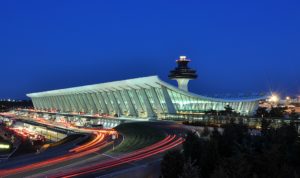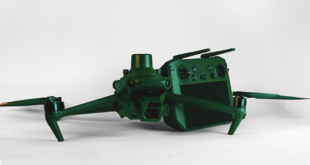Joe Ravi [CC BY-SA 3.0]
The technology for controlling access to airspace around airports or other protected facilities is ready – but will regulations allow them to be implemented before the next damaging event?
The following is a DRONELIFE exclusive guest post from Jaz Banga, CEO and Co-founder of Airspace Systems, a Silicon Valley-based company leading the development of aerial security systems for enterprise.
Consider this sequence of recent events:
- Over the course of 33 hours in late December, rogue drones over London’s Gatwick Airport disrupted 1,000 flights and the plans of 140,000 passengers.
- A couple of weeks later in early January, drones stopped air traffic for an hour at London’s Heathrow Airport.
- Then a couple of weeks after that, there were reports that drones halted more than 40 flights headed to Newark Liberty International after a United pilot said he nearly hit a drone within 30 feet of his right wing.
The lesson here is pretty obvious. We need to do everything we can now to protect American airports—their employees, the travelers, their property—from criminals, or just careless use of drones.
Although this threat has been building for years, American aviation rules have left airport executives confused about what they can do about the threat. Can they use the latest tech available now to keep their airports and communities safe from drones or not?
In a crucial but little-known meeting in February, FAA officials made clear to American airport executives that, yes, they have the authority to use drone safety technology — with exceptions.
Proceed with caution
Few issues are as important to the professionals in charge of more than 850 U.S. airports than protecting against drones.
“We keep our finger on the pulse of our members,” says Justin Barkowski, staff vice president at the American Association of Airport Executives (AAAE). “And this issue matters a lot to them. They see drones as one of the top threats to the safety of their airports, and they’ve wanted to do something about it.”
The FAA’s recent clarification of its July 2018 letter helps them do that.
That letter made clear the FAA would not allow airports to interdict rogue drones — that is, capturing them out of the sky.
Less clear to airport executives, however, was the FAA’s stance on using drone detection systems, which the AAAE says had confused its members, discouraging them from embracing effective solutions.
While the FAA still prohibits airports from using technology that interdicts drones in the air, the agency wants airport executives to know: they can use detection systems, so long as they let the FAA know first.
“This was about clarity,” says Barkowski. “The FAA’s reaffirmation of its July 2018 letter is going to give airports added certainty about investing in drone detection systems.”
Good step. We need more.
The FAA’s meeting with the AAAE in February was a great start. I anticipate that more U.S. airports will embrace the powerful detection tech we have today, and their surrounding communities will be better for it.
Let me repeat: I applaud the FAA’s clarification, and I think it will help move the needle on drone safety around airports.
But in my opinion, there are still big opportunities in airspace security of which the U.S. is not taking advantage.
Here’s one major reason why: The FAA is still working on rules establishing safety standards for drone detection or mitigation systems.
The last FAA Reauthorization Act, signed in October, requires that the agency create a pilot program to test how well drone safety tech performs. Part of the program, for example, mandates that detection and mitigation systems be tested at five airports as part of the testing and evaluation process.
The sad news is the program hasn’t really started in earnest.
Airport execs need to know which drone detection systems meet basic operating and safety standards. And they need to know which future tech they should start preparing for. Are they buying detection equipment today that can also be used to interdict drones a year or two from now?
Most airports make decisions years in advance, so we need to encourage the FAA to more quickly create a testing program or risk delaying deployment of drone safety systems even longer.
FAA, Meet DHS
In back-to-back reports, the Department of Homeland Security (DHS) has highlighted the looming dangers from drones.
In February 2017, DHS said the nearly threefold rise in commercial drone sales between 2016 and 2020 would mean threats posed by drones “will continue to expand in nature and increase in volume in coming years.”
A month later, in a department White Paper on autonomous technology, Homeland Security reminded itself that it needed to partner with companies creating technologies that could disable drones.
DHS concluded, “These threats need to be addressed before catastrophic consequences are unleashed.”
We’ve avoided catastrophes so far, but we’ve been lucky. It’s now time for airports to use the authority the FAA has given them to use powerful detection technology that’s available now, and make our skies safe, secure and open for business.
 Jaz Banga is CEO and Co-founder of Airspace Systems, a Silicon Valley-based company leading the development of aerial security systems for enterprise. Airspace is funded by the early backers of Nest, Palantir and Skype, and includes a management team from Apple, Google, and Cisco Systems. He is a member of the FAA’s Drone Advisory Committee. Prior to Airspace, Jaz founded Connected Patents, a team of experienced entrepreneurs that applied an innovative and unique approach to building and leveraging IP portfolios, assisting startups in successful M&A and IPO activity.
Jaz Banga is CEO and Co-founder of Airspace Systems, a Silicon Valley-based company leading the development of aerial security systems for enterprise. Airspace is funded by the early backers of Nest, Palantir and Skype, and includes a management team from Apple, Google, and Cisco Systems. He is a member of the FAA’s Drone Advisory Committee. Prior to Airspace, Jaz founded Connected Patents, a team of experienced entrepreneurs that applied an innovative and unique approach to building and leveraging IP portfolios, assisting startups in successful M&A and IPO activity.
Prior to Connected Patents, Jaz delivered Cisco Systems directed media core routers and licensed his intellectual property to Juniper Networks. As an inventor, Jaz holds 55 patents ranging from Internet connectivity to drone guidance systems, and delivered Google Wi-Fi to the City of San Francisco.
Miriam McNabb is the Editor-in-Chief of DRONELIFE and CEO of JobForDrones, a professional drone services marketplace, and a fascinated observer of the emerging drone industry and the regulatory environment for drones. Miriam has a degree from the University of Chicago and over 20 years of experience in high tech sales and marketing for new technologies.
Email Miriam
TWITTER:@spaldingbarker
Subscribe to DroneLife here.
https://dronelife.com/2019/04/18/airport-execs-want-the-authority-to-protect-their-communities-from-drones-now-the-faa-wants-them-to-know-they-have-the-authority-kind-of/
 Unmanned Aerial Vehicle The latest drone news
Unmanned Aerial Vehicle The latest drone news



